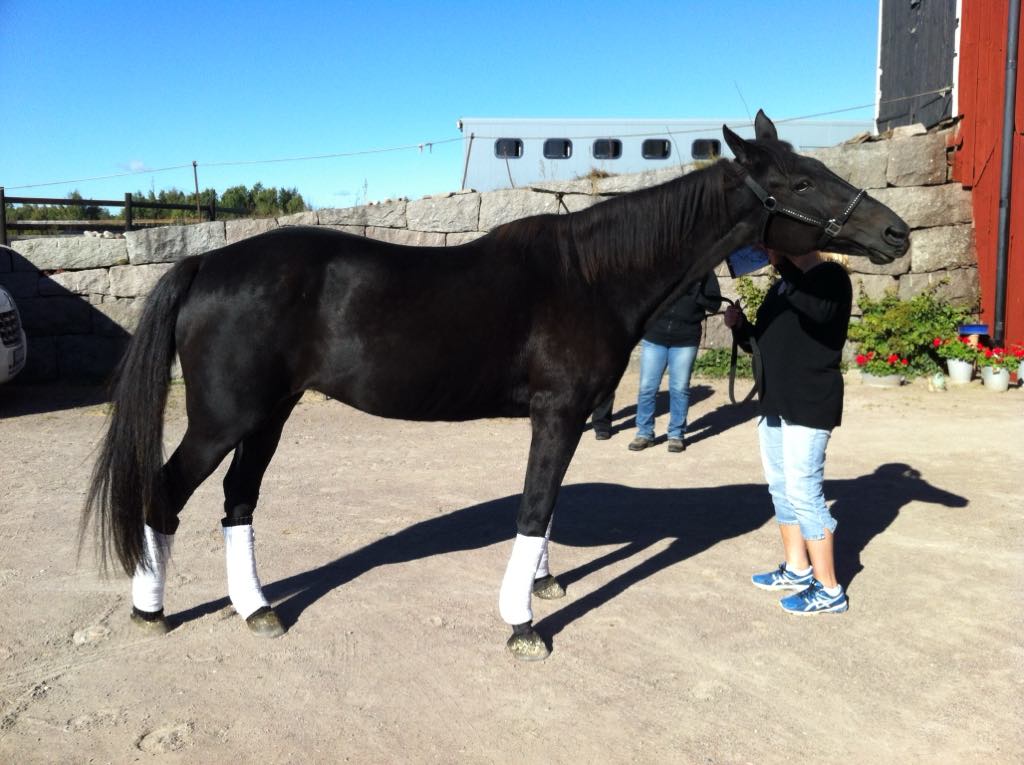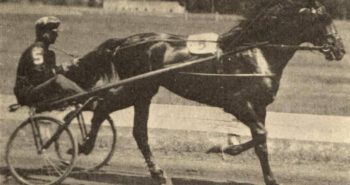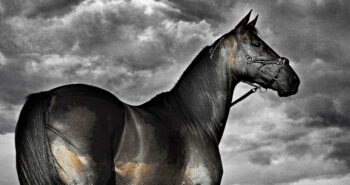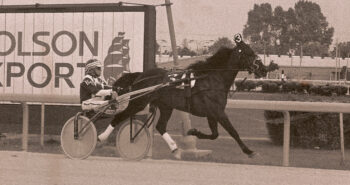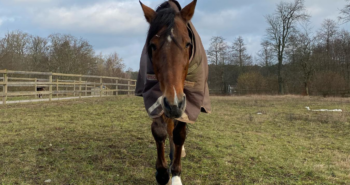When Soviet trainer Maria Burdova wanted to drive Apex Hanover in the Prix d’Amerique in 1965 she was denied with the explanation that sitting in a sulky “is an unnatural position for a woman.” 30 years later the world had finally moved forward and Helen Ann Johansson became the first female driver to win the Prix d’Amerique when she drove Ina Scot to victory.
The story of Ina Scot actually starts with an unhappy owner – or, more correctly, his friends. Carl-Henric Brandel, Ina Scot’s breeder, owned several horses in training with Kjell P Dahlström. According to Dahlström, “like many owners he listened to what others were saying, including a lawyer who was friends of the owners of Swedish Derbywinner Big Spender. He was saying to Brandel that they shouldn’t have their horses in our training. It is old and well-known, that it’s often the owners’ friends who move their horses.” But the move backfired and within two years, in the summer of 1990, Brandel called Dahlström and asked for help. Dahlström went to look at his horses and while he thought that “most horses were crap” – it’s probably not a big surprise to add that Dahlström wasn’t known to filter his comments – he did like the 3-year-old Boss Nephew. He had driven the horse earlier and knew it had some potential, so in his mind there was at least one horse he could help find new owners for. The only negative about the three-year-old in Dahlström’s eyes was the dam, Lovisa Grefgård, “a mare who just couldn’t trot.” Helen A Johansson later stated, in a Youtube interview with Johan Lindberg, that, “Lovisa Grefsgård was a big horse, a chestnut and very solidly built. She was put in our training, but we had recommended to the owners that she should be a pleasure horse for his kids as she couldn’t trot. She was clueless. Then the owner stated he was going to have her bred. Our advice was to not bother. But the owner stood firm.”
Examining the rest of the horses, he found nothing of interest as most had bad conformation or some other negative trait. When he was told to drive and look at a yearling filly five minutes away, he reluctantly agreed, though as he later described, “I promise I was negative and could just as easily have gone home. We drove even further into the deep forest. Then she was there. INA SCOT. Bloody hell, what a racing type! I walked back and forth and looked, and commented to Jörgen Axen who was there, have you seen anything more racing-like? Looks good, quipped Jörgen. Looks good!?! I walked around the filly several more times and said to myself that I just had to have her.”
A considerable amount
When Brandel said he wanted a considerable amount for Ina Scot, Dahlström was worried what “considerable” might be, but upon being asked 25,000 SEK, he immediately agreed. Though it wasn’t zero, the amount was in reality not considerable at all – in comparison, when Napoletano entered stud in Sweden a few years later his foal fee was 85,000 SEK. Dahlström and his wife Helen usually didn’t buy yearlings for themselves, instead they would sell them to existing owners – or recruit new owners. But selling Ina Scot proved difficult as he felt he couldn’t tell potential owners she was a future star and then only ask 25,000 for her. At the same time, increasing the price would only scare people off. Though she looked good, people didn’t fancy her pedigree. Her sire, Allen Hanover, was a decent trotter but hadn’t won any big races and didn’t have a huge appeal. The maternal pedigree wasn’t much better. Her dam, Lovina Grefgård, had a brother, Bosse Boss, who was relatively good, but the damsire/damdamsire combination of Mad Scot and French trotter Lowton did nothing to attract potential buyers – if anything it scared people away.
The previous year, Dahlström had four owners who had bought an Ideal du Gazeau yearling. The horse didn’t develop as intended and when he wanted the horse gelded, three of the owners said no and wanted to move the horse to another trainer. But the fourth owner, Sune Liden, wanted to stay with Dahlström and the others bought him out. When told he was paid 34,000 SEK for his part, the outspoken Dahlström claimed the other owners had overpaid by 33,000… Ina Scot qualified early as a two-year-old and when given the chance to buy a share, Liden quickly said yes.
The insane winning streak
Ina Scot was a star from the get-go, she did everything right immediately and there were never any problems. In 8 starts at 2 she was 4-2-0 without Dahlström asking much from her at all. After finishing 6-2-2 in her first three starts at 3, Ina Scot then started in a Swedish Breeders Crown qualifier at Jägersro. After a fast-paced opening, Ina Scot just breezed by everybody and won comfortably. She then started in – and won – 13 more races that year including all the biggest races for Swedish 3-year-olds such as Svenskt Travkriterium, Breeders Crown and Färjestads Nordiska Treåringspris, though in the latter she had to work to keep Danish star Rudolf Le Ann at bay. She also lowered the record for 3-year-old Swedish-born fillies to 1.14,6 (2:00f). The trainer was now convinced Ina was something truly special. “Dad felt early on that she was a really good horse, but it was only when she started to win race after race as a 3-year-old that he felt that she was a future star,” Carola Dahlström, daughter of Kjell, points out.
Dahlström’s super-filly stood at 14 straight wins and the winning streak just continued at 4. In 1993, aged 4, she made 17 starts and she incredibly won all 17. She won all the big races except Sprintermästeren, which Dahlström decided to skip as he did not want to risk two fast heats on the same day. But Ina Scot won the Swedish Derby, the Breeders Crown, Drottning Silvias Pokal, Stochampionatet and, perhaps most impressively, the Grand Prix de l’UET with almost ridiculous ease against other top European 4-year-olds. She also lowered the record for 4-year-old Swedish-born fillies from 1.13,6 to 1.12,6 (from 1:58.2f to 1:56.4f).
At the end of Ina’s spectacular 1993 season, Ina Scot became even more of a family affair as Dahlström’s daughter Carola took over as groom – but it took a bit of convincing. “It was not a given that I was going to care of Ina. I was living in the US when she finished her four-year-old season. Veronika, her groom at the time, wanted to quit, so both she and my father pestered me, and I was finally persuaded to move back to Sweden to take over. I never thought I would experience what I did in the coming years with her. She was such a lovely horse and it’s hard to describe. Ina knew she was a star but not in a diva sort of way. She clearly showed what she liked and didn’t like, she was ticklish when I brushed her and I had a special brush that she liked. When I harnessed her ahead of a race and she had to wait a while, she showed her nervousness by starting to scratch her hooves. Then I slowly caressed her pasterns, and she would calm down,” she recalls.
However, in the interview with Lindberg, Johansson offered a slightly different perspective on whether Ina displayed any diva behavior. “She knew how good she was, oh, what a diva she was. She was bossing the other horses on the farm, every human, her grooms… Both Veronika and Carola, she got them to do exactly as she wanted. She decided everything. Everything,” she said with a little laugh.
“The risk of being killed was otherwise too high”
Amazingly Ina Scot’s winning streak, at 31 wins, would come to an end in her seasonal debut at 5. Dahlström had promised his home track, Mantorp, that she would make her return from her winter break in an easy race. What was supposed to be another easy victory turned into misery when Fay Topline came out of nowhere and narrowly beat Ina. Dahlström, disappointed and angry, quickly disappeared into his stable after the race. The ordinarily outgoing, bubbly and motormouth trainer was in absolutely no mood to talk or even be around people. As another trainer put it: “we all left him alone as the risk of being killed was otherwise too high.”
But amateur trainer Lennart Fjellström failed to realize the danger and Dahlström’s mood… He popped his head in: “Listen Kjell, I’ll give you a piece of advice. Try a Norwegian bridle, that works well on these mares.” It was said that Dahlström could accept any criticism of himself, his family, his wife, his children, in fact anything but criticism of Ina Scot – who was holy ground to him. When Dahlström stared at the visitor with an angry look and then started walking slowly toward him, Fjellström realized his mistake and supposedly exited the stable in record time.
But Ina Scot returned to her winning ways quickly and impressively. Just 12 days after her loss, she brushed aside Peace Corps and Ideal du Suede to win Silverhästen at Solvalla. “It was tougher for Ina to assert herself against the elite and when she lost her first start as a 5-year-old, many thought she wouldn’t make it. However, after that loss she went out at Solvalla in Silverhästen, won easily and it displayed an incredibly strong psyche. It was one of many races that felt great”, says Carola Dahlström.
Ina Scot won 10 of 20 starts at 5, including Forus Open in Norway and St Michel Race at the ultra-fast Mikkeli track in Finland. Ina didn’t have a great day and failed to qualify for the Elitlopp final as Pine Chip humiliated the European opposition in her elimination heat. She also got a bit of a reality check in both the Jubileumspokalen and Preis der Besten where she ended out of the money. On the whole, it was a season of learning and adjusting to a new level, but it finished on an upward trajectory and at the end of the year she looked very strong.
“I’m too heavy for the uphill”
At the beginning of 1995, Dahlström and Johansson took Ina down to France to try her against the top European elite at Vincennes. Queen L had won the Prix d’Amerique two years prior and thus proved it was possible for a Scandinavian-born trotter to succeed. But Ina’s first race in France, the Prix de Belgique, turned out a disappointment as the mare finished well behind the Scandinavian trio Shan Rags, Houston Laukko and Bicycle, who shocked the French by excluding French horses from the top-3. The 1995 Prix d’Amerique would pit heavy favorite Vourasie, Ourasi’s excellent sister who was expected to win the biggest race just like her brother, against Queen L, with Norwegian trotter Shan Rags third-favorite in the betting while Houston Laukko and Sea Cove were the two outsiders. Ina Scot was not seen among the favorites, but Dahlström had a plan. “I’m too heavy for the uphill at Vincennes, Helen is 34 kilos (75 lbs) lighter than me,” he said and decided that wife Helen A Johansson would drive Ina in the Prix d’Amerique.
Some thought it made a lot of sense, but many were surprised or shocked. Johansson was 33 years old and “only” had 144 wins so far in her career but was given the nod to drive Ina Scot in the biggest world’s biggest race for aged trotters. The decision was not met with open eyes in France. “The French thought the Swedish were crazy and that I would have zero chance of even surviving the race. They thought I was fragile as a porcelain doll, and that I would break. There was so much resistence, I even heard that I would be beheaded. I had never driven at Vincennes before, and never with that starting method, either. That Sunday I probably felt like the loneliest person on earth”, Johansson later confided in a 2021 interview with Rikstoto.
Going into the race, Helen got a perfect start and immediately found Vourasie’s back, though that was accidental. Johansson then drove with a simply, yet absolutely perfect strategy. Point marking Vourasie, Johansson ensured Ina stayed on her tail. When Vourasie maneuvered, Ina followed her and when Vourasie was advancing four-wide in the last turn, Ina Scot was again hot on her tail. It made perfect sense as Vourasie always had a trademark strong finish, and Ourasi’s little sister thus ensured Ina had a very favorable position out of the last turn. Down the final stretch Vourasie advanced to the front, causing the Vincennes crowd to go crazy. To be a true trotting queen in France one needs to win the crown jewel that is the Prix d’Amerique, and it finally looked like Vourasie would earn the honor after Queen L and Sea Cove had stood in her way the previous years. But as the French trotting fans were approaching heaven, the feminine Swedish duo on her back tipped right. Under heavy urging, Ina Scot gradually moved closer and closer and after a tough duel, Ina Scot beat Vourasie by small margin.
“It will forever be the moment of all moments. That we succeeded together that day. It was huge. I will never forget it and am proud and humbled by everything I was able to be a part of. And I hope that I meant something to all the girls and women who have entered the sport since then,” Johansson stated later.
“She makes the impossible possible“
Ina Scot’s victory wasn’t an ordinary victory. Not only did Helen A Johansson win and became historic, but in a way, the whole of Sweden won that race. Ever since her winning streak got going, Ina Scot had grown into a massive fan favorite and a horse of the people in her native Sweden – and Dahlström certainly encouraged that. When Ina Scot won the Stochampionatet and scored win 23 in her 31-race long streak, a happy Kjell P Dahlström in the winners’ circle invited everybody at Axevalla that day to come visit Ina at their farm, “but please, don’t come all at once” he added. Dahlström, nicknamed “Sheriffen” (the sheriff) loved to show off, entertain and play to the crowd. When Ina started in an ordinary overnight race at Axevalla, he insisted they serve cake to everybody in attendance – and 5,820 people showed up… But people didn’t come for the cake, they came to see the horse and her trainer. At the local grocery store an 80-year old woman came up to him and said “I love that filly, please take good care of her” and Dahlström probably nailed it when he explained why he thought Ina was so popular; “Ina Scot was not an expensive horse, she’s from a small place, she’s a relatively small mare, she’s trained by Helen and me, and we are not big trainers. She’s also personifying the dream of glory, the dream of money. She makes the impossible possible.”
Dahlström and Ina Scot also get a lot of fan mail. Most letters were adressed to the trainer, but a few letters were even adressed directly to Ina. One letter came from Carina Jonsson, manager at the Umåker racetrack in Northern Sweden. Jonsson wrote directly to Ina Scot and encouraged the horse to persuade her trainer to start in a race at Umåker. The track didn’t offer a lot of big races and hadn’t gotten many visits from big name trotters at the time, but the letter paid off; in between starting in bigger races in southern Sweden and going abroad to France, Germany, Italy and Norway, Ina Scot started at Umåker in August 95. Naturally, she won in impressive fashion.
Three months after the Prix d’Amerique win, Ina Scot won the Lotteria in Naples in straight heats. She again failed to qualify to the Elitlopp final and had a bit of a mixed second half of the season. In 1996, at the age of 7, she finished fourth in the Prix d’Amerique, won by Coktail Jet, and was a very popular winner of the Oslo Grand Prix in world record time. But when she failed to qualify for the Elitlopp for the third time in a row, and a veterinary check showed several issued, she was retired. Johansson later stated she wished they would have retired the legendary mare after her win in Oslo: “I was clear that the Oslo Grand Prix should have been her last start. She wasn’t in the best of health then, but miraculously she found strength somewhere which made her sprint fiercely down the final stretch run to an easy victory,” she stated later in an interview with Rikstoto.
As a broodmare
Ina Scot had five foals. In 1998 Ambassadeur Brunn, a colt by Donerail, was born. He never made it to the track. She was then sold to the German millionaire Michael Schröer, breeder of the “November”-horses. In 2000, Ina gave birth to a talented filly, Nordic Gold November, by Viking Kronos. A winner of 10 of 20 lifetime starts, Nordic Gold November won the 2003 German Filly Derby and was later a good broodmare. Ina Scot then had three sons, all by the German stallion General November, a son of Valley Victory out of a full sister to Florida Pro. Paul November, born 2002, was the best of the trio. Paul November was a 1.10,5 (1:53.2f) trotter who won 18 of 109 races and reached a relatively high level.
Ina Scot’s maternal family goes back to Uhleen born 1907, a daughter of Bingen and Blondella and thus a full sister to the legendary Uhlan. Uhleen’s daughter Miss Uhleen Brooke was exported to Sweden in 1937. The part of the maternal family that stayed in the US are almost exclusively pacers, and the most notable names include 1992 Little Brown Jug-winner Fake Left, PASS champion Handsoffmycupcake and Landmark Hall.
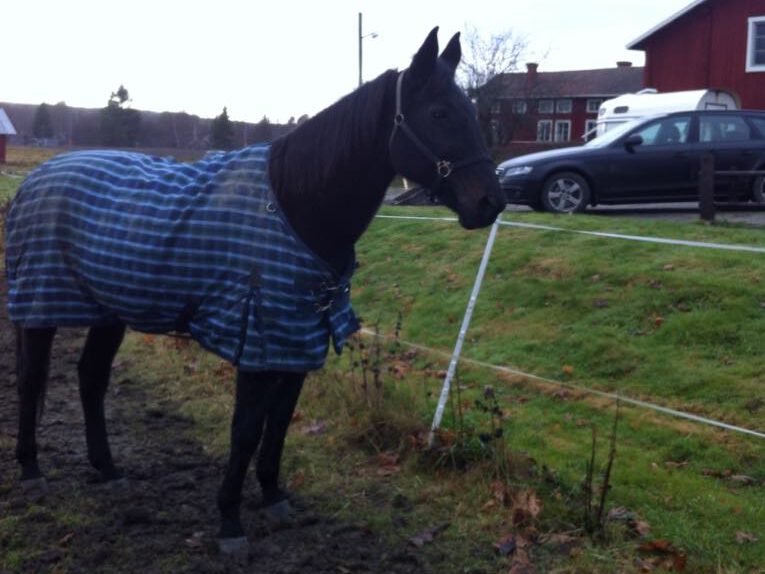
In the fall of 2013, Michael Schröer sent Ina Scot back to Sweden to let her live out her days with former groom Carola Dahlström. “When she came to me in 2013 it felt like she hadn’t aged at all, even though I hadn’t seen her for 18 years,” her groom points out. However, Dahlström’s joy over having Ina Scot back didn’t last too long. After an accident, she had to be humanely euthanized roughly four months after returning to Sweden, on Dec 21, 2013. She was buried at the Mantorp racetrack in Sweden. Kjell P Dahlström died from a heart attack almost immediately after finishing fourth in a race at Jägersro on Dec 21, 1997 – curiously enough, exactly 16 years to the day prior to his queen passing away.
Ina Scot was inducted into the Scandinavian Hall of Fame in 2013, while Helen A Johansson was inducted in 2024.
ina scot
Brown filly born in Tranås, Sweden on Jun 22, 1989. Died in Söderhamn, Sweden on Dec 21, 2013.
Allen Hanover – Lovina Grefgård (Mad Scot)
90 starts: 54-11-6 – Fastest win: 1.12,2 (1:56.1f) – Fastest time: 1.11,6 (1:55.1f) – 20,252,530 SEK
Breeder: Carl Henrik Brandel
Owners: Stall Kung Karl – Kjell P Dahlström AB, Ina-Q AB – Kjell P Dahlström AB and Michael Schröer
Trainer: Kjell P Dahlström
Drivers: Kjell P Dahlström and Helen A Johansson
Grooms: Veronika Karlsson and Carola Dahlström

